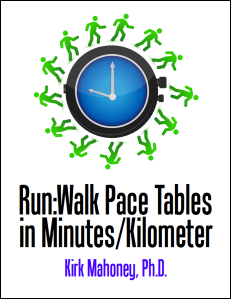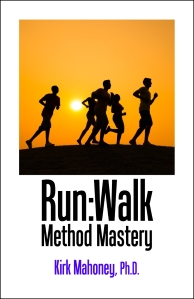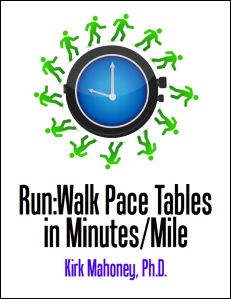Run:Walk Pace Tables in Minutes/Kilometer
The run:walk method is as popular as ever, but is the guesswork with minutes/kilometer pacing and run:walk ratios making you confused, tired, and unhappy?
I love the run:walk method.
 Hi, I’m Kirk Mahoney, the author of Run:Walk Pace Tables in Minutes/Kilometer.
Hi, I’m Kirk Mahoney, the author of Run:Walk Pace Tables in Minutes/Kilometer.
I also wrote Run:Walk Pace Tables in Minutes/Mile, which is the English-system companion book for those of us who pace ourselves in minutes per mile instead of in minutes per kilometer.
Why did I write these two books?
I love the run:walk method. I trained for my first marathon with the run:walk ratio of 5:1. I now train regularly with people who use ratios of 10:1, 5:1, and 3:1. My best average pace in training has been with the 1:1 ratio. And, my marathon personal best (PB) came by racing with the 2:1 ratio.
But, before I wrote these books, I saw a HUGE gap in the run:walk community.
This gap has been causing a lot of unnecessary confusion and unhappiness.
These two books close that gap.
Is the run:walk method driving you crazy?
If you are like me, here is why you love the run:walk method:
- You get a better workout because you use your muscles differently.
- You get more variety during a workout or race.
- You get predictable milestones in a race or training session.
- You get more stamina.
- You get fewer injuries.
- Last but not least, you can get faster chip-times!
All of this contributes to greater happiness as an endurance athlete, and I’m all about happier running and walking!
Unfortunately, there has been a gap that has driven many of us run:walk athletes crazy.
Let me talk more about that in a moment…
Do you prefer guessing, folklore, driving directions, or a map?
Seriously, how do you figure out just the right combination of running and walking on any given day and for any given race or training distance?
Let’s compare it to driving from point A to point B:
- You could guess. Some of us have done this, at least when we were younger. “Well, let’s see. If I want to go to the convention center, then I guess that I’ll start by driving toward downtown and keep looking for the big building along the way.”
- You could rely on folklore. Many of us have done this. “A neighbor told me that I should take highway X to somewhere around street Y and then go left until I get to street Z … and the convention center will be around there somewhere.”
- You could use driving directions. A lot of us do this now. We get driving directions from a GPS unit, which can work well … until the unit dies suddenly or there is an unexpected obstacle. Or, we go online, enter our starting point and destination, and print the directions. Still, printed directions cannot handle unexpected detours, and they give you no sense of the greater territory around, say, the convention-center destination.
- You could use a map. I know — “What’s that?!” Yes, you have to learn how to read maps. You have to locate on a map where you are now and where, say, the convention center is. But, a map eliminates guessing and folklore, never dies suddenly, and gives you options — LOTS of options — when one route or another is blocked.
Pace calculators are like driving-directions websites.
Yes, you could search the Web and find some run:walk pace calculators that will let you enter some variables to get some other variables.
A pace calculator is like a driving-directions website. You enter some stuff, and it tells you what to do.
That’s fine, as far as it goes.
But, what if you were to run into an obstacle? Would you know what to do?
The fact is, you could poke and prod all day with a pace calculator and still not end up with the big picture about how YOU can best use the run:walk method.
In contrast, pace tables are like maps.
Now, think about a map. It gives you the big picture, and this gives you LOTS of options to achieve your goal.
Pace tables are like maps. They give you the big picture and lots of options to achieve your goal.
So, what is the gap that this book fills?
Of course, you can find many constant-pace tables in books, magazines, and websites. There are even websites where you can print pacing wristbands to wear in a race so that you stay on pace for your chip-time goal.
The aforementioned gap is the lack of pace tables for the run:walk method.
Sure, there have been some simple attempts to create a run:walk pace table or two.
But…
These simple attempts are like giving you a torn-off piece of a map — enough, perhaps, to get you started, but not enough to help you to reach your goal, especially if something has to change along the way.
In contrast, Run:Walk Pace Tables in Minutes/Kilometer is a complete map!

You have run:walk questions? This book has answers!
Run:Walk Pace Tables in Minutes/Kilometer answers typical questions like these from run:walk athletes:
- “If I want to use the 5:1 run:walk ratio to finish a marathon in five hours, what combinations of running and walking paces will let me do it?”
- “If I change from the 10:1 ratio to the 9:1, 8:1, or 7:1 ratio without changing my running and walking paces, how much will this affect my chip-time in a half marathon?”
- “If I like the 6:1 ratio and I cannot run any faster, how will increasing my walking pace affect my finishing time in a 3K, a 5K, or a 10K?”
- “What are the typical trade-offs in a 50K for changing my running pace, my walking pace, and my run:walk ratio?”
- “If I want to finish a 10-miler in 1:45, which of these should I adjust: my run:walk ratio, my running pace, or my walking pace?”
- “If I want to finish a 25K in under 3:00, how much must I increase my running pace when I slow my walking pace?”
- “If I want to finish a 30K in 3:40 or faster but I cannot change my running and walking paces, then what run:walk ratio should I use?”
Possible questions like these are almost limitless, but Run:Walk Pace Tables in Minutes/Kilometer can answer all of them.
What if you are not a run:walk athlete now?
If you run or walk at a constant pace but have wondered whether adopting the run:walk method could work for you, then Run:Walk Pace Tables in Minutes/Kilometer is the best book for you.
You see, not only do you get a HUGE collection of tables, you also learn from the book the answers to three most popular questions among run:walk athletes:
- What is the best way to pace my running and walking?
- How do I “stay on schedule” with a run:walk ratio?
- How do I keep a “rhythm” to my run or walk?
This book may not be for you.
I admit it. My books, including this one, are not for everyone.
Some athletes like my advice but don’t follow it because it takes work.
They want to buy an event instead of engage in a process (more on that in a bit).
So, let me warn you that this book is NOT for you, if…
- You have no interest in using the run:walk method.
- You want to be told what to do with the run:walk method and are not inquisitive about trade-offs among run:walk ratios, running paces, and walking paces.
- You use the run:walk method and all of your races are at the same distance, but you are unwilling to be flexible with your paces or run:walk ratio.
So, who should get this book?
You will LOVE this book, if…
- You pace yourself in minutes/kilometer.*
- You use the run:walk method today, or you are interested in trying it.
- You want to find just the right combination of a running pace, a walking pace, and a run:walk ratio that will give you the right combination of comfort, endurance, and chip-time across any of twenty different race distances and depending on your training or racing goals and how you feel on any given day.
*Get the English-system companion book — Run:Walk Pace Tables in Minutes/Mile — if you pace yourself in minutes/mile.
What is the heart of the book?
Run:Walk Pace Tables in Minutes/Kilometer gives you a complete map:
- You get ten different run:walk ratios — from 10:1 down to 1:1.
- You get twenty different race distances — from 3K to 50K.
- You get lots of running and walking paces — from 3:45/kilometer to 10:30/kilometer.
Printed in a spacious 8.5×11″ format, this works out to 200 pages of easy-to-read tables in a 224-page softcover book.

See this book as a process, not as an event.
You already know that it is the process, not the event, of completing a marathon, half marathon, or other endurance race that bolsters your happiness.
The best way to see this book is as a process, not as an event.
For example, you could use the book to determine how you could sandwich some 2:1 “speed work” into the middle of a long training session with the 5:1 ratio.
Or, as another example, you could study the tables and create a racing plan to combine 5:1, 9:1, 1:1, and 3:1 ratios into a larger cycle that would give you great variety on race day.
These are examples of process, whereas simply looking up a single number or two is an event for which you may as well use a pace calculator instead.
It comes down to clarity.
Buying, studying, applying, and repeatedly checking this book will give you clarity about how best you can use the run:walk method for your chip-time goals and your favorite distances, paces, and run:walk ratios.
The purchase price of Run:Walk Pace Tables in Minutes/Kilometer is set modestly around the price of an interval timer, which I highly recommend. The bigger initial investment is in the hour or two that you will spend reviewing the tables inside it.
But, the potential payoffs — including faster race times, more endurance, and greater comfort — are priceless!
Plus, you will want to return to this book repeatedly for further insights about ratios and paces, such as every time that your training or racing ever hits a lull — and you know that it will!
So, using this book takes work. This is a process, not an event. But, as with endurance training and racing, the greatest joy and clarity come from the process, and this book enables that process!
Get It Now
Get Run:Walk Pace Tables in Minutes/Kilometer here in spacious 8.5×11″ paperback:
Review It at Goodreads
What about Kindle?
Ebooks do a horrible job of presenting tables. Get the paperback. You’ll be glad that you did!
What Other Athletes & Coaches Said
I wholeheartedly personally endorse Dr. Kirk Mahoney’s Run:Walk Pace Tables, as it is very thorough and filled with great information. This book contains terrific suggestions of how to use this running/walking method using predetermined run intervals followed by walk intervals such as 5:1. Many years ago I started out running straight runs but found in many marathons that I simply ran out of gas around mile 20, causing my last 6 miles to be mostly walking and very slow. Then I learned about the 5:1 method, and it’s worked so well for me that I set my marathon personal record using it and now incorporate it into every long-distance race. Thank you, Kirk, for such an accurate and detailed long-distance running aid.
Bette Branch Lehmberg, CPA, J.D.
Marathon runner since 1996. 5:1 athlete and coach for 10+ years. Finisher of countless 5Ks and 10Ks, 100+ half-marathons, and 25 marathons.
My first marathon was last year. Full of worry over timing my 5:1 intervals, I used Dr. Mahoney’s then-available tables to help me establish a bench-mark walking time to reduce the walking-interval’s impact on my overall time. The timetables really demonstrated how little impact a minute interval has on your overall time. I have continued interval training and am thrilled that Dr. Mahoney has now completed timetables for varying intervals for all different race lengths. Thanks for doing the math, and thanks for such a useful tool to both reach goals and maximize fitness.
Juli Crow, J.D.
Runner for three years. Finisher of countless 5Ks and 10Ks, five half-marathons, and one marathon. Now training for her second and third marathons with the run:walk method.
For 26.2 and shorter distances, I’ve been doing more straight-through running. When it’s hot or I’m feeling suboptimal or for races longer than 26.2, then I add in a bit of the 5:1 or 10:1 run:walk. But, with longer runs, the terrain typically isn’t flat, so I would walk any incline and run the rest.
This book provides very useful details for planning the run:walk paces for your training runs and races.
M. Lam
Runner for four years. Finisher of eight marathons, two 50Ks, and one 50-miler. Occasional user of the run:walk method.
Dr. Mahoney has done all the work for those of us that do interval training. Thank you for making it so easy.P. Young
5:1 athlete for four years. Finisher of 25+ half-marathons and nine marathons. Now starting to use the 10:1 ratio.
My name is Pamela Granata. I am the owner and publisher of Walk About Magazine. I have been publishing Walk About for the past 10 years. Walk About is the only walking magazine in the U.S. I have been a coach for Portland Fit for the past 11 years. The first two years I was an assistant “Red” coach, and then I became the head coach for the walkers. I have been a runner since the age of 12, running on a women’s track team and traveling the U.S for cross-country, indoor track meets as well as outdoor track meets. At the age of 14 I was 14th in the nation at the AAU Cross Country Nationals. I continued to run throughout my adult life, running countless 5Ks. Once I moved to Portland, OR, in 1999, I discovered Portland Fit and trained for my first marathon. I ran/walked that marathon and two more using the run/walk method. I used the 9:1 because it was easier for me to calculate. I will be 60 this year and am always inspired when I look at the results after a race and see all of the finishers well into their 80s. I continue to compete in 1/2 marathons.
I found this book to be extremely beneficial because it simplified everything for me. I am not a technical person and have never used a GPS other than my phone, and that sometimes proved to be a struggle. The run:walk pace tables made so much sense, and I quickly adapted my paces, and now it has become so much easier. I recently walked/ran the Helvetia Half Marathon, and I remained pain-free/injury-free the entire race. I highly recommend Run:Walk Pace Tables and will be introducing Dr. Mahoney’s method with my group training for the Portland Marathon.Pam Granata
Publisher, Walk About Magazine (WalkAboutMag.com)

